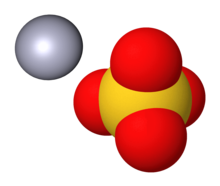Mercury(II) sulfate

| |

| |
| Names | |
|---|---|
| Other names
Mercuric sulfate, Mercurypersulfate, Mercury Bisulfate[1]
| |
| Identifiers | |
| |
| ECHA InfoCard | 100.029.083 |
PubChem CID
|
|
| UNII | |
CompTox Dashboard (EPA)
|
|
| Properties | |
| HgSO4 | |
| Molar mass | 296.653 g/mol |
| Appearance | white monoclinic crystals |
| Odor | odorless |
| Density | 6.47 g/cm3, solid |
| 450 °C (dec.)[2] | |
| Decomposes in water to yellow mercuric subsulfate and sulfuric acid | |
| Solubility | soluble in hot H2SO4, NaCl solution insoluble in alcohol, acetone, ammonia |
| −78.1·10−6 cm3/mol | |
| Structure | |
| rhombic | |
| Thermochemistry | |
Std enthalpy of
formation (ΔfH⦵298) |
−707.5 kJ mol−1[3] |
| Hazards | |
| NFPA 704 (fire diamond) | 
3
0
1 |
Except where otherwise noted, data are given for materials in their standard state (at 25 °C [77 °F], 100 kPa). | |
| Infobox references | |
Mercury(II) sulfate, commonly called mercuric sulfate, is the chemical compound Hg S O4. It is an odorless solid that forms white granules or crystalline powder. In water, it separates into an insoluble sulfate with a yellow color and sulfuric acid.[3]
History[]
In 1932, the Japanese chemical company Chisso Corporation began using mercury sulfate as the catalyst for the production of acetaldehyde from acetylene and water. Though it was unknown at the time, methylmercury is formed as side product of this reaction. Exposure and consumption of the mercury waste products, including methylmercury, that were dumped into Minamata Bay by Chisso are believed to be the cause of Minamata disease in Minamata, Japan.[4]
Production[]
Mercury sulfate, HgSO4, can be produced by heating concentrated H2SO4 with elemental mercury:[5]
- Hg + 2 H2SO4 → HgSO4 + SO2 + 2 H2O
Or by dissolving solid yellow mercuric oxide in concentrated sulfuric acid and water. [6]
Uses[]
Denigés' reagent[]
An acidic solution of mercury sulfate is known as Denigés' reagent. It was commonly used throughout the 20th century as a qualitative analysis reagent. If Denigés' reagent is added to a solution containing compounds that have tertiary alcohols, a yellow or red precipitate will form.[7]
Production of acetaldehyde[]
As previously mentioned, Hg S O4 was used as the catalyst for the production of acetaldehyde from acetylene and water.[8]
Oxymercuration-demercuration of alkenes[]
Mercury Compounds such as mercury sulfate and mercury(II) acetate are commonly used as catalysts in the oxymercuration-demercuration, a type of Electrophilic Addition reaction. The hydration of an alkene results in an alcohol that follows regioselectivity that is predicted by Markovnikov's Rule[citation needed].
Hydration of alkynes[]
The reaction scheme is provided below. The conversion of 2,5-dimethyhexyn-2,5-diol to 2,2,5,5-tetramethylte-trahydrofuran using aqueous mercury sulfate without the addition of acid.[9]

Health issues[]
Inhalation of HgSO4 can result in acute poisoning: causing tightness in the chest, difficulties breathing, coughing and pain. Exposure of HgSO4 to the eyes can cause ulceration of conjunctiva and cornea. If mercury sulfate is exposed to the skin it may cause sensitization dermatitis. Lastly, ingestion of mercury sulfate will cause necrosis, pain, vomiting, and severe purging. Ingestion can result in death within a few hours due to peripheral vascular collapse.[1]
It was used in the late 19th century to induce vomiting for medical reasons. [1]
References[]
- ^ Jump up to: a b "Chemicalbook". Retrieved 2 May 2011.
- ^ Wu, Shengji; Uddin, Md. Azhar; Nagano, Saori; Ozaki, Masaki; Sasaoka, Eiji (2011). "Fundamental Study on Decomposition Characteristics of Mercury Compounds over Solid Powder by Temperature-Programmed Decomposition Desorption Mass Spectrometry". Energy & Fuels. 25 (1): 144–153. doi:10.1021/ef1009499.
- ^ Jump up to: a b Lide, David R. (1998). Handbook of Chemistry and Physics (87 ed.). Boca Raton, Florida: CRC Press. pp. 5–19. ISBN 0-8493-0594-2.
- ^ Minamata Disease. Boston University. Retrieved 2016-11-10.
- ^ Mercury in Your Environment | US EPA. Epa.gov (4 October 2016). Retrieved 2016-11-04.
- ^ Robey, R. F.; Robertson, N. C. (May 1947). "Test for tert-Butyl and Isopropyl Alcohols with Deniges Reagent". Analytical Chemistry. 19 (5): 310–311. doi:10.1021/ac60005a007.
- ^ Marks, E. M.; Lipkin, D. (1939). "Reaction of Aliphatic Ethers with Denigés' Reagent". J. Org. Chem. 3 (6): 598–602. doi:10.1021/jo01223a008.
- ^ Vogt, R; Nieuwland, J (September 1921). "The role of mercury salts in the catalytic transformation of acetylene into acetaldehyde, and a new commercial process for manufacture of paraaldehyde". J. Am. Chem. Soc. 43 (9): 2071–81. doi:10.1021/ja01442a010.
- ^ Wasacz, J. P.; Badding, V. G. (1982). "A hydration of an alkyne illustrating steam and vacuum distillation". Journal of Chemical Education. 59 (8): 694. doi:10.1021/ed059p694.
External links[]
| Wikimedia Commons has media related to Mercury(II) sulfate. |
- Sulfates
- Mercury(II) compounds